Hot plants for dry places
Lucky for us, the New Zealand climate is relatively benign. We don’t have it so tough, for example, as the poor old Aussies, battling relentless drought and water restrictions. But climate change is upon us. More than ever we’re facing extremes of wet and dry weather and long spells without rain. We need to factor this into the way we garden, and what we plant. The good news is that breeders are helping matters by coming up with ever more drought resistant plants.
Choosing plants that suit your soil and climate is a first line of defense against adversity, especially on sandy coastal sites or where summer watering is difficult.
When a plant suffers from water stress its cells collapse, resulting in slower growth and often, irreversible damage to their roots so they wilt even when watered and are left vulnerable to attack by pests and diseases.
Shelter
In a dry, windy location it makes sense to start by planting trees and shrubs. Their roots grow deep into the soil where there is moisture, so once established, they cope without watering for much longer than smaller, more shallow-rooted plants. Trees and large shrubs also provide shelter, which means less wind to whip the moisture from your garden.
Trees and shrubs for shelter - Metrosideros (Pohutukawa), Pittosporum, Olearia, Corokia, Banksia, Coprosma, Griselinia.
Cover
On a hot mid summer day, a square metre of bare soil can lose around two litres of water to the air. The very best way to prevent this is to cover your soil. A blanket of organic mulch topped up every spring makes all the difference. For the longer term you could plant permanent ‘living mulch’ using dry tolerant groundcover plants.
Groundcovers - Coprosma, Muehlenbeckia, Grevillea, Osteospermum (Cape daisy), Ophiopogon (Mondo grass), Sedum, Hemerocallis (daylily).
Desert dwellers
The most obvious drought lovers are those that evolved in the desert, developing the ability to store water in their cells, thick waxy skins or furry coats to protect against water loss. Succulents are the camels of the plant world!
Easy succulents - Aeonium ‘Schwarzkopf’, Echeveria elegans, Aloe, Sedum.
A touch of silver
No dry garden is complete without its silver highlights. Silver foliage almost always indicates a dry tolerant plant. Favourite silver groundcovers include Stachys lanata (lambs ears) and Cerastium (snow in summer). Quick growing Teucrium fruticans is a favourite for trimming to shape. Too often overlooked, native Brachyglottis ‘Otari Cloud’ is a tough and showy little shrub that should be planted more often. Compact daisy, Leucanthemum 'Sparkles' has silvery leaves and striking white flowers with yellow centres.
Silver foliage - Helichrysum, Brachyglottis, Cerastium, Dichondra ‘Silver Falls’, Stachys, Teucrium, Santolina, Pachystegia (Marlborough rock daisy).
Extra texture
Designed by nature to grow where wind blows, grasses and flaxes add movement and excitement to a planting scheme and many of them cope well in dry soils.
Flaxes, grasses and grass-like - Cordyline, Lomandra, Phormium (Dwarf mountain Flax), Libertia (NZ iris), Carex comans and Carex testacea (NZ tussock grasses).
Herbs
Dry tolerant plants come from dry places, which is why the Mediterranean herbs are go-to plants for pots and dry garden beds.
Mediterranean herbs - Lavender, rosemary, thyme, sage, borage, oregano, marjoram, French tarragon.
Flower power
Other plants belie their lavish looks with surprising drought tolerance. These robust summer bloomers include some of our most beloved container plants.
Pot perfect - Nicotiana, Pelargonium (geraniums), Petunia (and calibrachoa), Tagetes (marigold), Verbena.
A hot summer flower border - Achillea, Bergenia, Dianthus, Echinacea, Gaura, Kniphofia, Lychnis, Osteospermum, Penstemon, Phlomis, Sedum, Salvia, Sisyrinchium, Verbena.
Tough all-rounders
For many drought tolerant plants drainage is critical, which can rule them out on soils that are dry in summer but wet and boggy in winter. In heavy clay soils we can improve drainage by creating raised beds or laying drainage. Adding lots of organic matter in the form of compost and mulch will improve clay soil over time. In the meantime we can plant tough all-rounders that cope with the full gamut of soil challenges. Clay has always been prevalent in New Zealand soils, so it’s not surprising that we have many native plants that are ‘tough pioneers’.
Clay tolerant - Griselinia littoralis , Hoheria populnea (Lacebark), Sophora (Kowhai), Callistemon (Bottlebrush), Cistus (rock rose), Coprosma, Eriostemon (Wax Flower), Leptospermum (Manuka), Phormium (Flax), Flower Carpet roses, Carex secta (NZ tussock).
Eight ways to save water
- Mulch with organic matter (such as straw, granulated bark, and composted leaves).
- Train your plants to cope with less water by gradually increasing the days between watering.
- Fix leaky taps, hoses and fittings.
- Plant more shelter.
- Remove weeds.
- Water early in the morning, or in the evening.
- Use trickle irrigation attached to a timer.
- Choose dry tolerant plants.
30-Sep-2015
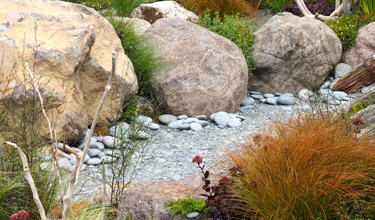
Sedum and NZ tussock grass Carex testacea
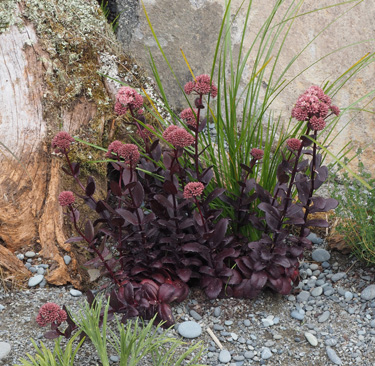
Sedum 'Chocolate Drop'
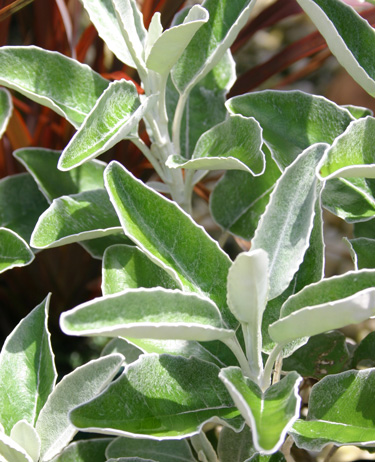
Brachyglottis 'Otari Cloud'
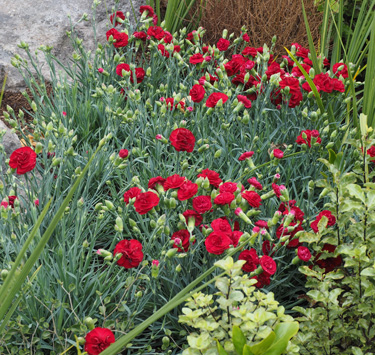
Dianthus
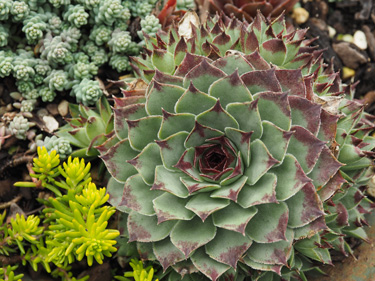
Succulents Sedum and Sempervivum


